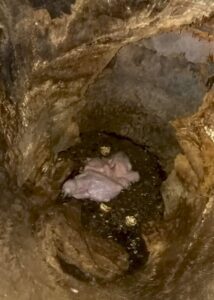
At first glance, the tree in question was unremarkable—kind of a lonely straggler in the middle of a cow pasture on a Sarapiquí farm. But upon further review, this individual Mountain Almond tree (Dipteryx panamensis) has been a miracle worker for the Great Green Macaw population of Costa Rica.
The 150 foot tree was home to three separate macaw nests in the 2020 breeding season: Dipteryx panamensis remains a favorite for these cavity-nesting birds.
Macaw Recovery Network Field Team Leader, Mario Jiménez, got to see the magic up close and personal. In 2020, MRN received permission from the farmer who owns the property to climb and study the tree, which the team named “Cascade”. Mario was rappelling from the top down when he heard a sound. He investigated the deep, dark cavity—sticking his head in for a peek—and was greeted by a trio of raucous macaw chicks. (Watch the encounter here!)

“They were already huge,” he said, estimating that the chicks were probably about 1.5 months old when he found them. (Great Greens are among the largest of the macaws) “As soon as they saw me, they got really loud!!” he laughs.

This nest was a full 100 feet off the ground, and further down the tree were nests at 85 and 75 feet. Of the 7 total chicks that hatched, 6 fledged (made their first flight) from the tree, bringing a new batch of genetic diversity into a wild population which still is on the brink throughout its range, from Central America to coastal Ecuador.
That a lone tree could produce 6 viable individuals underscores how important the restoration of native flora is in Costa Rica. Until recent years, the Mountain Almond tree was difficult to cut—it’s a very dense tropical hardwood that could break chainsaws. But newer technology makes it easier to cut the trees, and increasing monoculture in Costa Rica of crops including pineapples have led to major clearances of Mountain Almond trees and other native plants.
Although a nest box program has been successful, ultimately MRN wants to return the forests of Costa Rica to their original splendor. With this in mind, MRN developed a Native Tree Nursery in 2019, which includes 2000 Mountain Almond seedlings harvested from the wild. It will take generations to see the results for trees that only grow about 6 feet per year, but MRN has boots on the ground, germinating more than 20 other native species in its nursery and investigating their role in the lifecycle of the Great Green Macaws. The birds rely on dozens of other plants for foodstuff in addition to the almendra (almond).

Combining two of its ambitious and innovative projects, a group of Costa Rican Women Rangers hired by MRN in 2020 will begin planting the Mountain Almond saplings around the Boca Tapada area later in 2021. This swampy zone bisected by the San Carlos River in the north of Costa Rica remains a Great Green Macaw stronghold.

Mario Jiménez called his encounter with the Great Green chicks “a parrot lover’s dream,” and with your support MRN will continue its work in Costa Rica, and in spreading the word internationally on conserving Great Green Macaws and the special avian genera called macaws.
We appreciate your support and ask you to continue to speak out against deforestation and the illegal trapping of birds for the pet trade. Your support of our Habitat and Outreach programs in local communities can help bring about a generational shift that sees macaws as wild, free-flying creatures and not caged pets, and forests as valuable components of ecosystems that should be left standing, not chopped down for short-term gain.
By Brian Kluepfel
MRN Contributor
